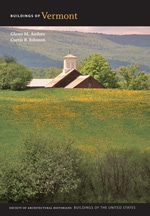
John W. Hartshorn, a prosperous farmer, built this one-and-a-half-story, wood-frame house that reflects the St. Johnsbury orientation of Lunenburg society as well as a number of popular trends in Vermont's rural architecture after the Civil War. The simple gable-front building and side ell are detailed in a Gothic Revival/Queen Anne manner, with lobed vergeboards, a turned-post porch with a decorative jigsawn slat rail, corner pilasters, and narrow nine-over-nine sash windows paired beneath peaked window hoods with nine cornice brackets. These distinctive window hoods occur frequently in St. Johnsbury's commercial and residential buildings and the trim likely originated there. The house has a side-hall plan marked on the exterior by a door and paired window instead of the symmetrical door-window-window fenestration of side halls built in earlier styles. Hartshorn and his wife retired here after giving his old farmhouse to his son and daughter-in-law. This common practice populated rural village centers throughout Vermont after the Civil War, replacing the earlier tradition of accommodating two generations in one farmhouse, usually by outfitting the house with two kitchens and two parlors.

